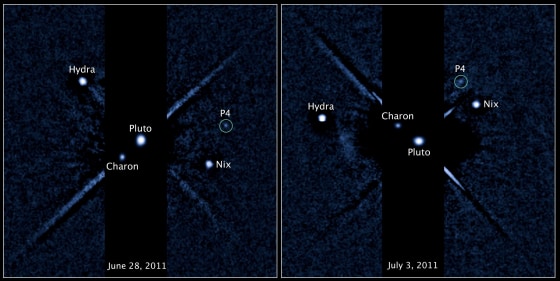Astronomers looking for rings around Pluto have instead made an unexpected find: a fourth moon circling the dwarf planet.
The object, temporarily designated P4, is probably the most dwarvish of Pluto's moons: It's estimated to be just 8 to 21 miles (13 to 34 kilometers) in diameter. In comparison, Pluto's diameter is about 1,400 miles, and its other three moons range in diameter from 648 miles (for Charon) to between 20 and 70 miles (for Nix and Hydra, discovered in 2005). The newfound moon orbits in a region between Nix and Hydra, and makes a complete circuit roughly every 31 Earth days.
P4 was detected in June, during a round of Hubble Space Telescope observations aimed at looking for rings or other potential hazards for NASA's New Horizons probe, which is due to zoom through the Pluto system in 2015. Alan Stern, a planetary scientist at the Southwest Regional Institute who heads the $700 million New Horizons mission, told me in an email that the discovery was a testament to the dwarf planet's continuing ability to surprise.
"Pluto's satellite system is truly knocking our socks off with surprises — it's magnificently complex, and getting more crowded all the time. I can't wait till we get there to see what other surprises this planet and its moons have in store for us!" he said.
The find is also a testament to Hubble's amazing vision. The object was spotted on June 28 using the space telescope's Wide Field Camera 3, and its existence was confirmed through follow-up observations this month as well as a search through archived imagery. The moon was not spotted in earlier imagery because the exposure times were shorter.
"I find it remarkable that Hubble's cameras enabled us to see such a tiny object so clearly from a distance of more than 3 billion miles (5 billion km)," Mark Showalter of the California-based SETI Institute, who led the Hubble observing program, said in today's announcement from the Space Telescope Science Institute.
P4 and Pluto's other moons are thought to be the result of a cosmic collision between the dwarf planet and another celestial body early in the solar system's history. Astronomers believe a similar smash-up gave rise to Earth's moon.
Pluto has gotten a bad rap in the past few years, due to its reclassification by the International Astronomical Union in 2006 as a dwarf planet rather than one of the solar system's major planets. Stern sees Pluto as just a different kind of planet rather than an also-ran, and I tend to agree with him. In any case, the fact that the world has a thin atmosphere, changing seasons and more known moons than Mercury, Venus, Earth and Mars combined demonstrates conclusively that you don't have to be one of the big planets to be fascinating. And there may be more to come as New Horizons closes in for its 2015 rendezvous.
"Pluto can retain moons out to almost 100 times the distance of Charon," Stern pointed out.
Update for 10:30 a.m. ET: Although having moons is certainly cool, that doesn't automatically qualify a celestial body to be a planet. A fair number of craggy asteroids possess a moon, or even two. The way the IAU sees it, a "planet" is a roundish celestial body that circles the sun and has "cleared the neighborhood of its orbit," which is widely seen as a deficient definition. A "dwarf planet" is a sun-orbiting celestial body that's big enough to crush itself into a roundish shape, but hasn't cleared out its neighborhood. The way I see it, dwarf planets are planets, too. But I realize a lot of smart folks see it differently.
Connect with the Cosmic Log community by "liking" the log's Facebook page or following @b0yle on Twitter. You can also add me to your Google+ circle, and check out "The Case for Pluto," my book about the controversial dwarf planet and the search for new worlds.
